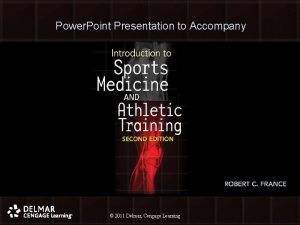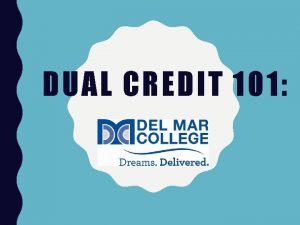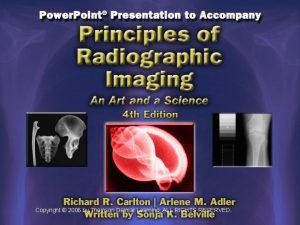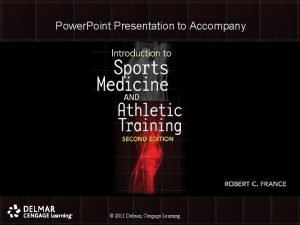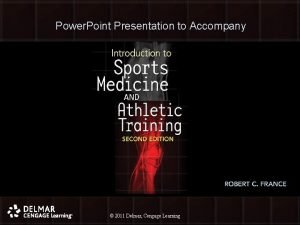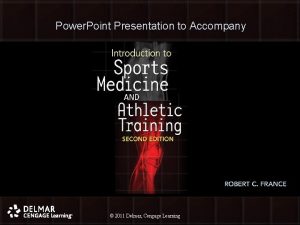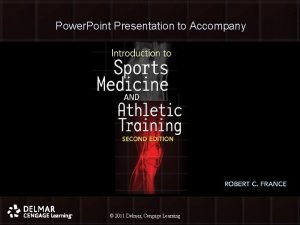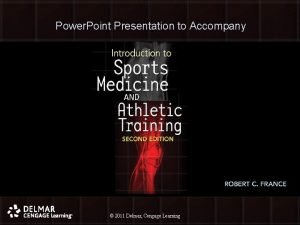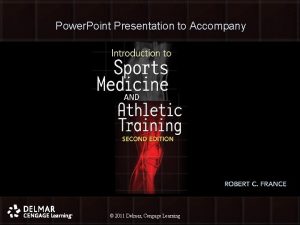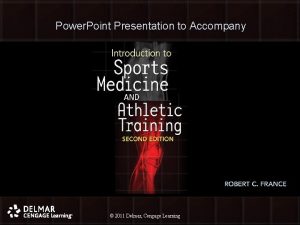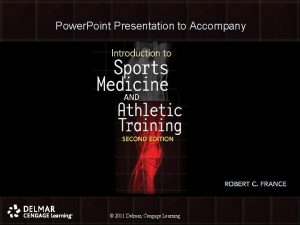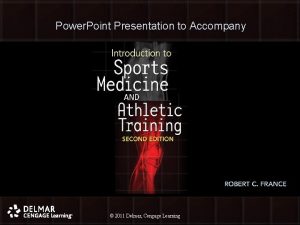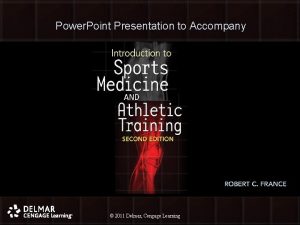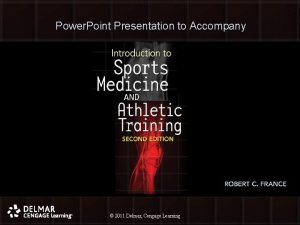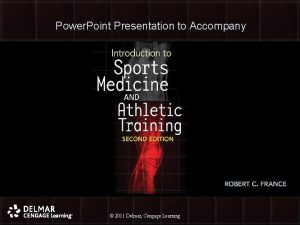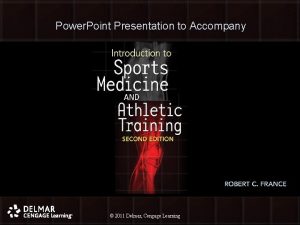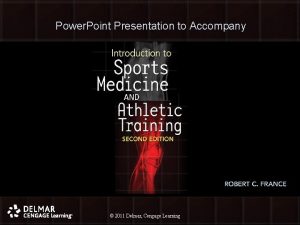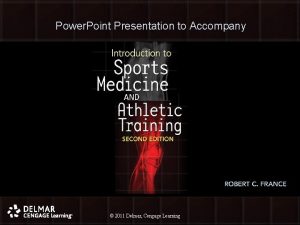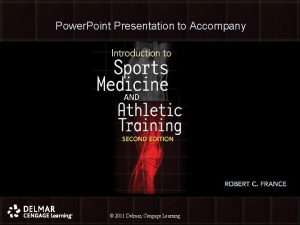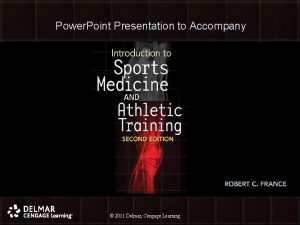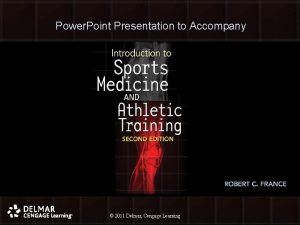Power Point Presentation to Accompany 2011 Delmar Cengage




















- Slides: 20

Power. Point Presentation to Accompany © 2011 Delmar, Cengage Learning © 2010 Delmar, Cengage Learning

Chapter 2 Athletic Training © 2011 Delmar, Cengage Learning © 2010 Delmar, Cengage Learning 2

Objectives • Upon completion of this chapter, you should be able to: – Describe the history and development of athletic training – Describe the role certified athletic trainers play in the athletic health care system – Explain the different skills required to be a certified athletic trainer © 2011 Delmar, Cengage Learning © 2010 Delmar, Cengage Learning 33

Objectives (cont’d. ) • Upon completion of this chapter, you should be able to (cont’d. ): – Describe the job market and opportunities that exist for certified athletic trainers – List various professional organizations available to certified athletic trainers – Discuss the Athlete’s Bill of Rights – Discuss liability and risk management and how they pertain to athletic training © 2011 Delmar, Cengage Learning © 2010 Delmar, Cengage Learning 44

What is Athletic Training? • Rendering of specialized care to individuals involved in exercise and athletics – Prevention, recognition, evaluation, and care of injuries • Athletic Trainer Certified (ATC) – Professional who has attained certification in athletic training © 2011 Delmar, Cengage Learning © 2010 Delmar, Cengage Learning 55

The Need for Athletic Trainers • Greater need for athletic trainers than ever before – Growth of females participants • Title XI: prohibits discrimination on the basis of sex as to participation in athletics in schools – Increase in youth sports – More college and professional athletes © 2011 Delmar, Cengage Learning © 2010 Delmar, Cengage Learning 66

The History and Development of Athletic Training • Galen (129 C. E. ) and Hippocrates (589 years later) contributed a great deal to science and medicine • American Medical Association recognized athletic training as an allied health profession in 1991 – One that contributes to or assists the professions of physical medicine, dentistry, optometry, pharmacy, and podiatry © 2011 Delmar, Cengage Learning © 2010 Delmar, Cengage Learning 77

Qualifications of a Successful ACT • Skills include: – Problem-solving ability – Deductive reasoning skills – Good judgment and decision-making skills – Proficient knowledge of anatomy, physiology, biology, and advanced first aid – Motor skills – Communication skills © 2011 Delmar, Cengage Learning © 2010 Delmar, Cengage Learning 88

Qualifications (cont’d. ) • Skills include (cont’d. ): – Ability to work well with people – Ability to work well under stressful conditions – Ability to maintain poise in emergencies © 2011 Delmar, Cengage Learning © 2010 Delmar, Cengage Learning 99

Qualifications (cont’d. ) • Tasks include: – Analyzing injuries – Taping and bandaging – Implementing exercise and rehabilitation programs for athletes – Monitoring rehabilitation programs – Demonstrating physical and rehabilitative movements © 2011 Delmar, Cengage Learning © 2010 Delmar, Cengage Learning 1010

Qualifications (cont’d. ) • Tasks include (cont’d. ): – Using various modalities (methods of treatment) and training equipment – Recording, organizing, and storing information on injuries and rehabilitation © 2011 Delmar, Cengage Learning © 2010 Delmar, Cengage Learning 1111

Qualifications (cont’d. ) • Code of conduct – ATCs must abide by the rules and procedures of their certifying organization – Failure to abide can result in disciplinary action or termination © 2011 Delmar, Cengage Learning © 2010 Delmar, Cengage Learning 1212

Qualifications (cont’d. ) • Education – Have a bachelor’s degree from an accredited program at a minimum – Study human anatomy, human physiology, biomechanics, exercise physiology, athletic training, nutrition, and psychology/counseling – Participate in extensive clinical experiences © 2011 Delmar, Cengage Learning © 2010 Delmar, Cengage Learning 1313

Qualifications (cont’d. ) • Certification – National Athletic Trainers’ Association Board of Certification, Inc. (NATABOC) examination • • • Prevention Recognition, evaluation, and assessment Immediate care Treatment, rehabilitation, and reconditioning Organization and administration Professional development and responsibility © 2011 Delmar, Cengage Learning © 2010 Delmar, Cengage Learning 1414

Work Settings for the ATC • Include: – Sports medicine clinics – Public and private high schools – Colleges and universities – Amateur and professional sports teams – Health and fitness centers – Businesses – Olympic teams and training centers – Hospitals and medical clinics © 2011 Delmar, Cengage Learning © 2010 Delmar, Cengage Learning 1515

Professional Organizations for ATCs • National Athletic Trainers’ Association (NATA) – Largest U. S. certifying organization for ATCs • Regional, state, and local trainers’ associations – Promote athletic training, wellness, and safety of athletes at the local level • Example: Ohio Athletic Trainers Association (OATA) © 2011 Delmar, Cengage Learning © 2010 Delmar, Cengage Learning 1616

Athlete’s Bill of Rights • No single standard – Common components include the right to: • • Have fun through sports Qualified adult leadership Participate in a safe and healthy environment Competent care and treatment of injuries Participate regardless of ability or income level Equal opportunity to strive for success Say “no” © 2011 Delmar, Cengage Learning © 2010 Delmar, Cengage Learning 1717

Liability and Risk Management • Hippocratic Oath – “I will follow that system of regimen [use treatment to help the sick] which, according to my ability and judgment, I consider for the benefit of my patients, and abstain from whatever is deleterious and mischievous [I will never use it to wrong them]” (Taber’s, 2001) © 2011 Delmar, Cengage Learning © 2010 Delmar, Cengage Learning 1818

Liability and Risk Management (cont’d. ) • Liable means “obligated according to law or equity; responsible” (Webster’s, 1993) – Athletic trainers take proper precautions to minimize exposure to lawsuits – Liability insurance is advisable © 2011 Delmar, Cengage Learning © 2010 Delmar, Cengage Learning 1919

Conclusion • ATCs possess skills, knowledge, and professionalism – This allows them to be respected members of the sports medicine community • Many career paths are open to ATCs • In addition to the National Athletic Trainers’ Association, most states have elected to certify or license athletic trainers © 2011 Delmar, Cengage Learning © 2010 Delmar, Cengage Learning 2020
 2009 delmar cengage learning
2009 delmar cengage learning 2009 delmar cengage learning
2009 delmar cengage learning Clinical conditions chapter 1 medical terminology
Clinical conditions chapter 1 medical terminology 2009 delmar cengage learning
2009 delmar cengage learning 2009 delmar cengage learning
2009 delmar cengage learning Chapter 13 medical math assignment sheet cengage learning
Chapter 13 medical math assignment sheet cengage learning Chapter 10 cultural diversity
Chapter 10 cultural diversity Delmar cengage learning instructor resources
Delmar cengage learning instructor resources Hebrews 6 9
Hebrews 6 9 Accompany chapter 1
Accompany chapter 1 Median cubital vein
Median cubital vein Accompany
Accompany Hindi presentation topics
Hindi presentation topics Power point presentation design west vancouver
Power point presentation design west vancouver Delmar isotonic
Delmar isotonic Delmar tsi
Delmar tsi Delmar customs broker windsor
Delmar customs broker windsor Delmar thomson learning
Delmar thomson learning Delmar larsen
Delmar larsen Power traiangle
Power traiangle Power bi power point
Power bi power point














